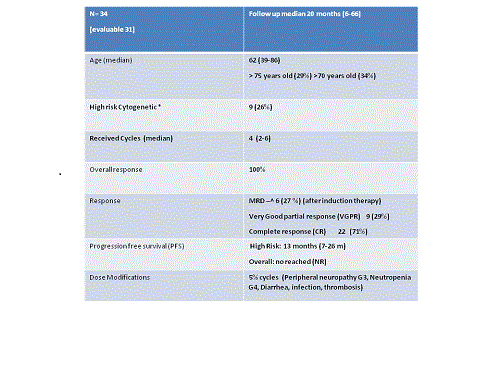
Contributions
Abstract: PB1666
Type: Publication Only
Session title: Myeloma and other monoclonal gammopathies - Clinical
Background
Achieving and maintaining high-quality response is the treatment goal for patients with newly diagnosed multiple myeloma (NDMM). Nowaday different schedaules of bortezomib, lenalidomida and dexamethasone are using. The phase 3 PETHEMA/GEM2012 study, in ≤ 65 years old with NDMM, is evaluating bortezomib (subcutaneous) + lenalidomide + dexamethasone (VRD) for 6 cycles. The ≥ very good partial response rates were 70.4% after induction. The complete response rate of 33.4% after induction in the intent-to-treat (ITT) population. Rates of undetectable minimal residual disease (median 3 × 10−6 sensitivity) in the ITT population was 28.8%.
Aims
We want to know the efficacy and safety of the induction therapy with VRD schedule in frail and fit NDMM patients in our institution.
Methods
we reported 34 NDMM patients who received VRD induction therapy since september 2015 until november 2020. All patients received first line treatment with VRD, which consisted of bortezomib 1.3 mg/m2 (subcutaneous) on days 1, 4, 8, and 11 of each cycle; lenalidomide 25 mg/day on days 1 to 21; and dexamethasone 40 mg on days 1 to 4 and 9 to 12 at 4-week intervals for 6 cycles (maximum or until better response). Thromboprophylaxis with low molecular weight heparin was mandatory. Antiviral prophylaxis was also required. MRD (median limit of detection, 3 × 10−6) was analyzed after induction using next generation flow following EuroFlow standard operation protocols as defined by the IMWG. Demographic characteristics are shown in Figure 1.
Results
Results of efficacy and safety are shown in Figure 1. High-risk cytogenetics, defined as t(4;14), t(14;16), gain 1p, and/or del(17p) (p53 deletion), were reported in 9 patients.

Conclusion
1) VRD is an effective and well-tolerated regimen for induction in NDMM with deepening response throughout induction.
2) VRD was well tolerated in transplant-ineligible patients.
3) High risk cytogenetic patients responded to treatment, but they need a long time better strategy.
Keyword(s): Bortezomib, Induction chemotherapy
Abstract: PB1666
Type: Publication Only
Session title: Myeloma and other monoclonal gammopathies - Clinical
Background
Achieving and maintaining high-quality response is the treatment goal for patients with newly diagnosed multiple myeloma (NDMM). Nowaday different schedaules of bortezomib, lenalidomida and dexamethasone are using. The phase 3 PETHEMA/GEM2012 study, in ≤ 65 years old with NDMM, is evaluating bortezomib (subcutaneous) + lenalidomide + dexamethasone (VRD) for 6 cycles. The ≥ very good partial response rates were 70.4% after induction. The complete response rate of 33.4% after induction in the intent-to-treat (ITT) population. Rates of undetectable minimal residual disease (median 3 × 10−6 sensitivity) in the ITT population was 28.8%.
Aims
We want to know the efficacy and safety of the induction therapy with VRD schedule in frail and fit NDMM patients in our institution.
Methods
we reported 34 NDMM patients who received VRD induction therapy since september 2015 until november 2020. All patients received first line treatment with VRD, which consisted of bortezomib 1.3 mg/m2 (subcutaneous) on days 1, 4, 8, and 11 of each cycle; lenalidomide 25 mg/day on days 1 to 21; and dexamethasone 40 mg on days 1 to 4 and 9 to 12 at 4-week intervals for 6 cycles (maximum or until better response). Thromboprophylaxis with low molecular weight heparin was mandatory. Antiviral prophylaxis was also required. MRD (median limit of detection, 3 × 10−6) was analyzed after induction using next generation flow following EuroFlow standard operation protocols as defined by the IMWG. Demographic characteristics are shown in Figure 1.
Results
Results of efficacy and safety are shown in Figure 1. High-risk cytogenetics, defined as t(4;14), t(14;16), gain 1p, and/or del(17p) (p53 deletion), were reported in 9 patients.

Conclusion
1) VRD is an effective and well-tolerated regimen for induction in NDMM with deepening response throughout induction.
2) VRD was well tolerated in transplant-ineligible patients.
3) High risk cytogenetic patients responded to treatment, but they need a long time better strategy.
Keyword(s): Bortezomib, Induction chemotherapy


